2024 Mercedes-Benz eSprinter Review and Test Drive
The eSprinter delivers all the capabilities of a proper cargo van teamed with a clean, efficient electric powertrain.
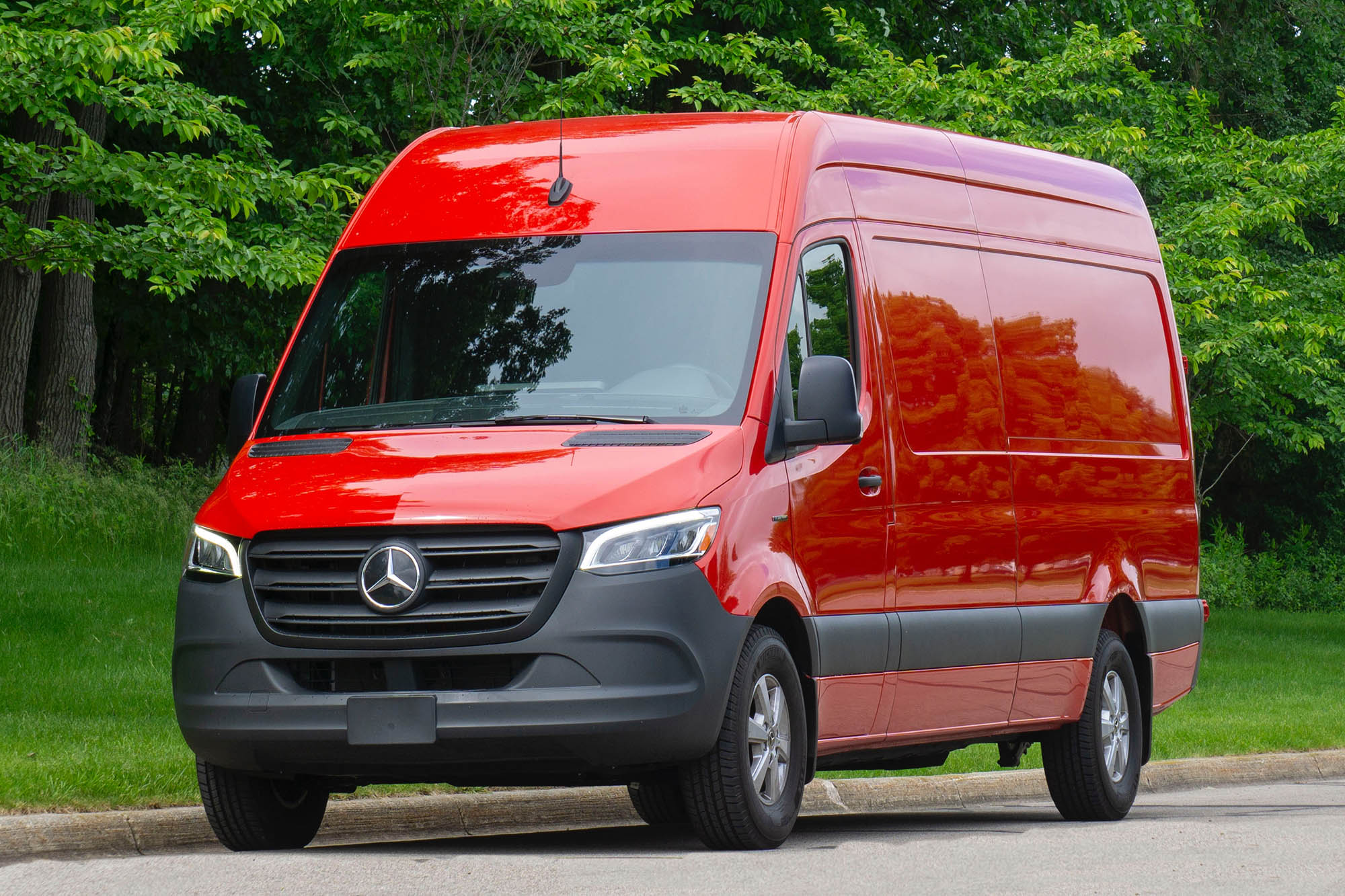 Perry Stern
Perry Stern
You see them everywhere, yet they just blend into the background. Full-size commercial vans are excellent for making local deliveries, hauling large equipment, or performing service calls. Some carry passengers, while others undergo conversion into Class B RVs. These right-sized vans are wildly versatile, and now, Mercedes-Benz has added a green version with its all-electric eSprinter.
While the eSprinter may be new, it builds on the success of its diesel-powered counterparts. However, the Sprinter isn't the only cargo van going electric. The Ford eTransit and Rivian Commercial 500 offer capabilities similar to the eSprinter but with a shorter driving range, while General Motors' new Brightdrop Zevo has more maximum cargo space.
This market is in its infancy, and there's almost certain to be more growth as the idea of an electric cargo van takes hold. On that note, the 2025 Ram ProMaster EV is set to add another choice in the segment.
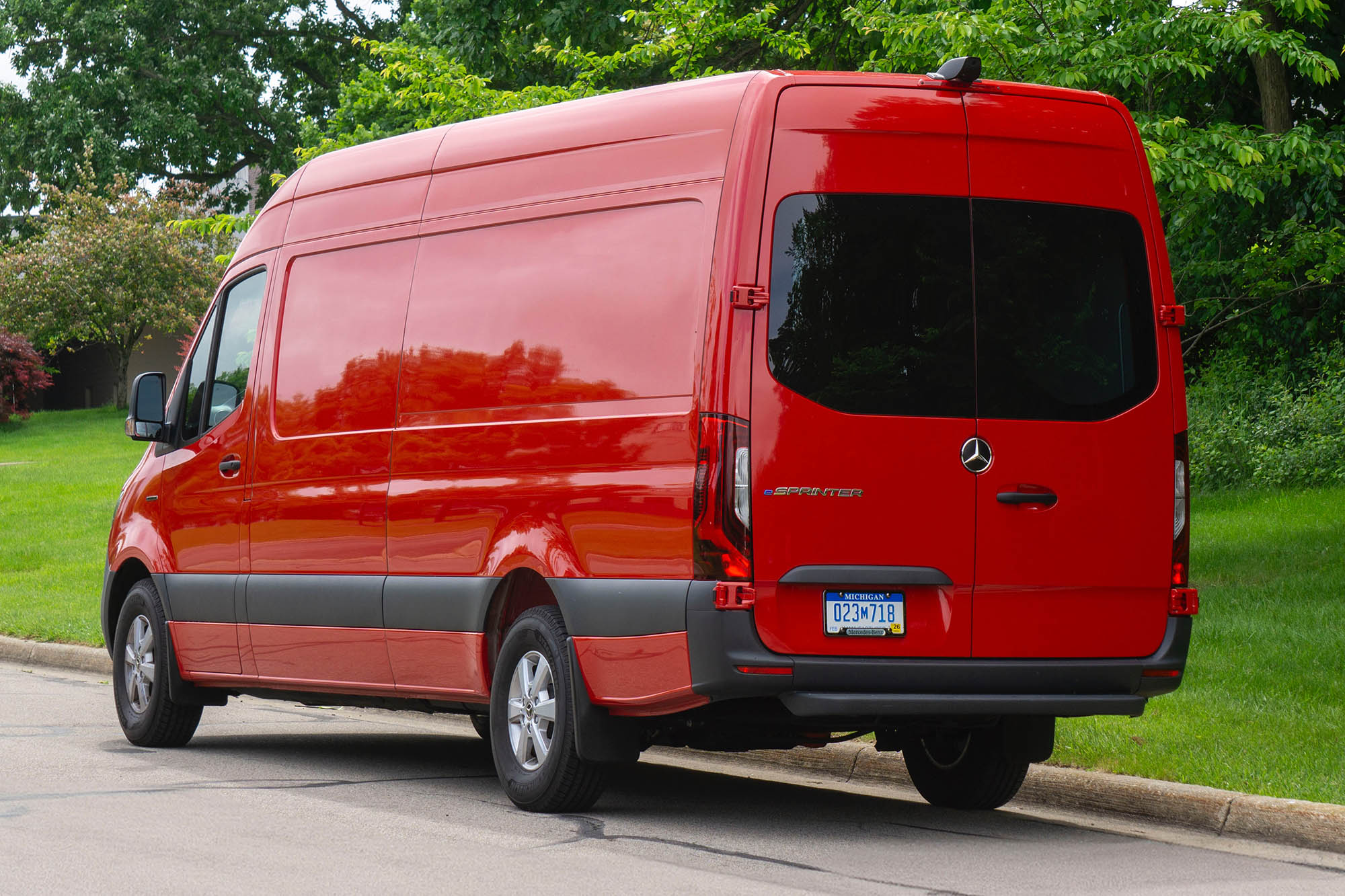 Perry Stern
Perry Stern
2024 Mercedes-Benz eSprinter Prices Are High
The 2024 Mercedes-Benz eSprinter comes in a single trim level with a standard 100-kilowatt (kW) or high-output 150-kW electric motor. The base price starts in the mid-$70,000s, including the destination charge to ship the van from the North Charleston, South Carolina, plant that builds it to your local dealership.
For those keeping score, that's over $20k more than a comparable gas-powered version.
For this eSprinter review, Mercedes-Benz provided me with the high-output version of the van for testing in southeast Michigan. Highlights from the optional equipment list included premium Sunset Red paint, light alloy wheels, the Premium MBUX Package, the Navigation Charging Package, and sliding-door electric closing assist.
The manufacturer's suggested retail price was $89,958, including the $2,295 destination charge.
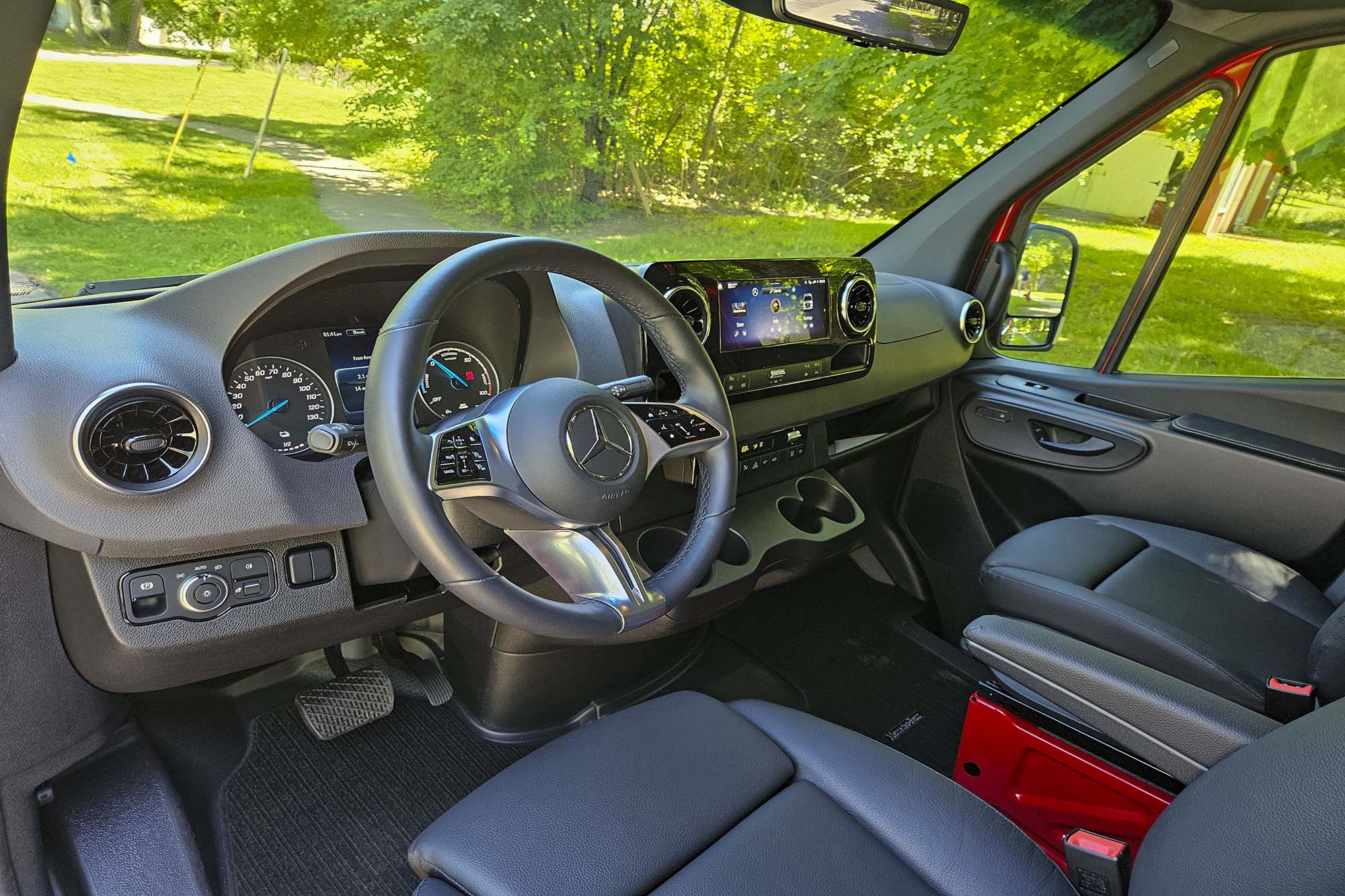 Perry Stern
Perry Stern
The Design of the eSprinter is Big and Boxy
The eSprinter's look is clearly the result of form following function. To maximize the available cargo space, the eSprinter is — for lack of a better descriptor — big and boxy. The styling is almost identical to the internal-combustion engine versions of the Sprinter, with only subtle differences in the grille. They look the same from a distance, but the large Mercedes logo is solid on the eSprinter, as it doubles as the cover for the conveniently located charging port.
The eSprinter's cabin is simple but well thought out, and it isn't as barebones as I expected. While Mercedes trims much of the interior with hard, durable plastic, it didn't look cheap to me. The available 10.3-inch touchscreen display and leather-wrapped steering wheel are a nice touch, as are the large, round vents.
Climate functions are in a separate section below the infotainment display and employ straightforward controls. In addition, there are buttons for quick access to features such as navigation, audio, and telephone as well as a volume control knob.
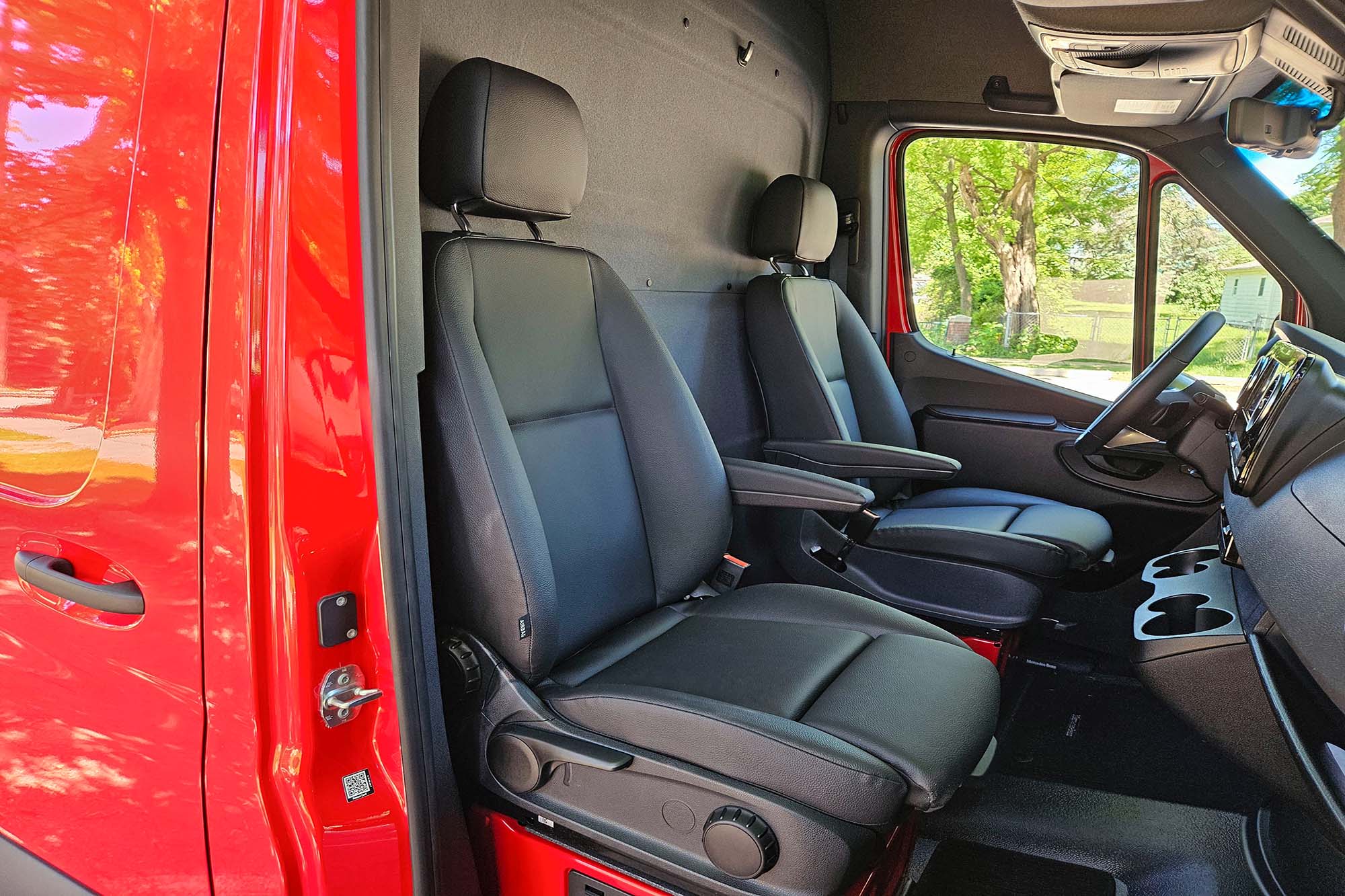 Perry Stern
Perry Stern
The Interior of the eSprinter Is Surprisingly Comfortable
Because it is a cargo van, the Mercedes-Benz eSprinter only has two seats. I found them comfortable and supportive, and the test vehicle had the optional synthetic leather upholstery. Despite manual adjustments, it isn't difficult to maneuver the driver's seat into a proper position. Sitting up high in the van behind the large windshield, the driver enjoys a commanding view.
Getting into the van is a bit of a climb, but the integrated step in the doorway makes it easy. The high roof means that even the tallest drivers will have more than ample headroom.
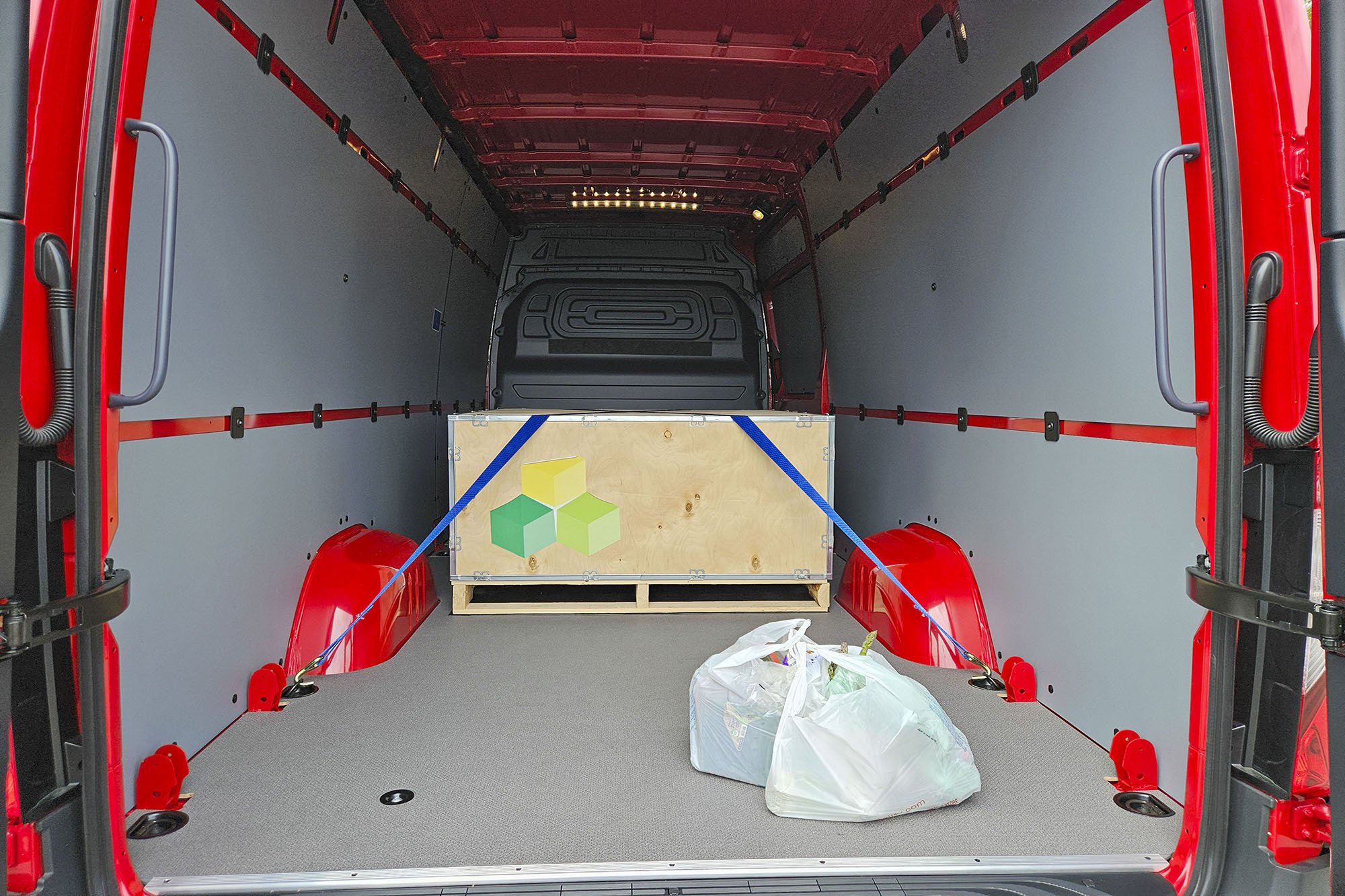 Perry Stern
Perry Stern
The eSprinter Provides Excellent Storage and Utility
The eSprinter is a cargo van, so yes, there's lots of space for cargo. But there is more to it than that.
Above the sun visors, there are shelves, and Mercedes locates another shelf in front of the passenger seat instead of providing a typical glovebox. In addition, there's space for storing small items on the top of the dashboard and a shallow covered bin in the center of the dash.
Between the two seats, there's plenty of room for a briefcase, backpack, toolbox, or, in my case, a couple of grocery bags that would have rolled around the cargo area. There's even a coat hook on the divider behind the seats. With so much available space, it would be nice to have additional covered or secured storage between the seats.
You access the cargo area via the two rear doors or a giant sliding door on the right side. With steps at either entry point, the eSprinter is easy to climb into and out of, even while carrying a heavy load. The rear doors open 90 degrees by default, but with a simple release, the doors can open to 270 degrees for added versatility.
Opening the eSprinter's rear doors reveals a cavernous cargo area. This van accommodates up to 488 cubic-feet of cargo, and with a ceiling height of 79.1 inches, there's plenty of space for most cargo-carrying needs.
While the space is immense, the electric model can't haul as much weight as the diesel vehicle's overall payload capacity. The eSprinter can handle up to 2,624 pounds of cargo, while diesel versions of the Sprinter can be configured to haul over 6,800 pounds. The eSprinter that Mercedes-Benz provided me was already loaded with a 440-pound crate, although the added weight did not seem to hinder the vehicle's performance.
Countless types of cargo could fill the eSprinter, but many of these vans make better use of the space through upfitting programs. Mercedes-Benz works with several vendors via its eXpertUpfitter solutions, which can accessorize the eSprinter with shelves and cabinets, workbenches, or other customizable options for work, such as a mobile workshop or delivery van.
In addition, the Sprinter van is the basis of many Class B RV conversions, and I expect the eSprinter will be a popular choice among RVers.
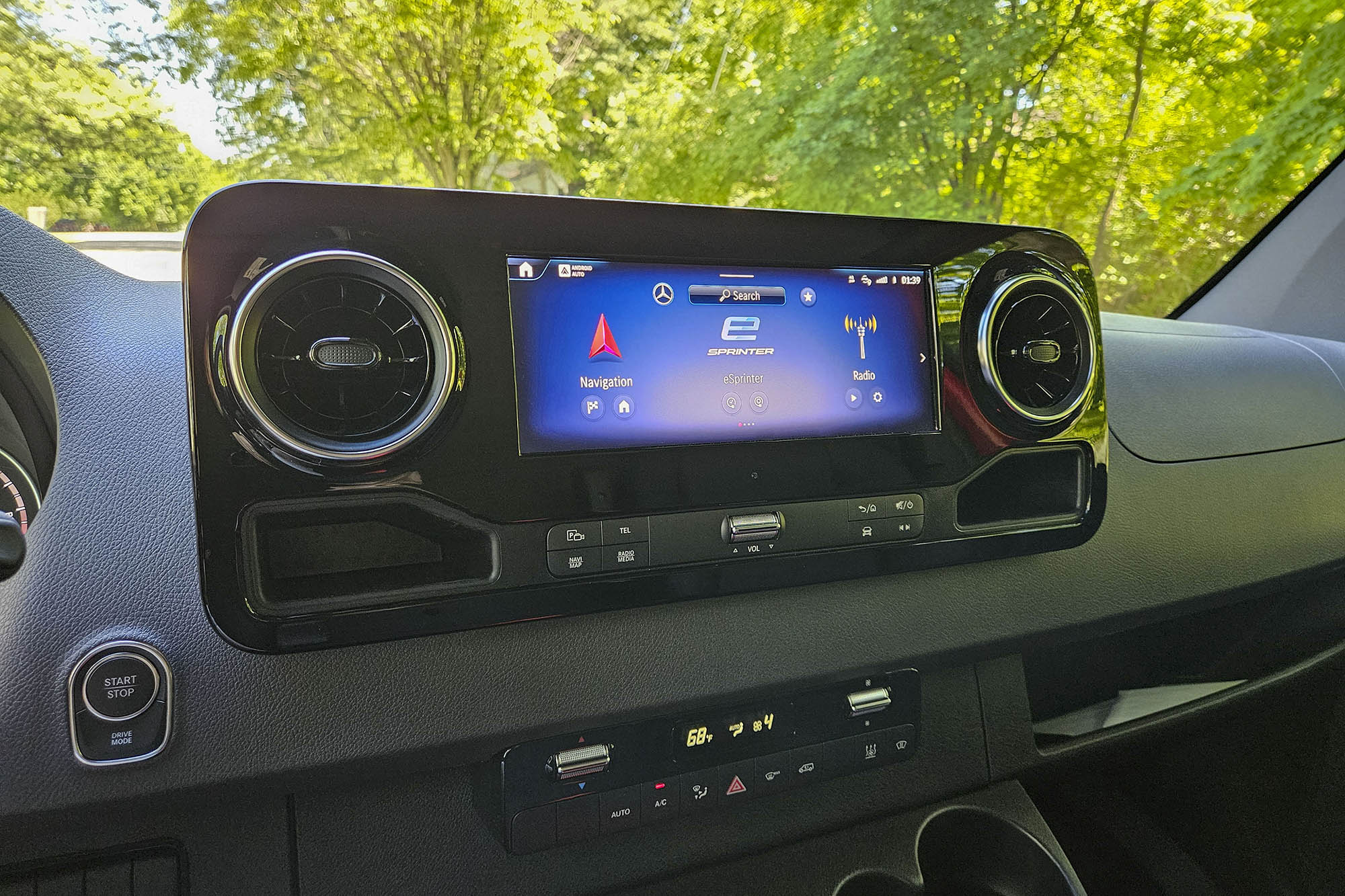 Perry Stern
Perry Stern
The MBUX Infotainment System Is Simple to Use
Mercedes-Benz offers the 2024 eSprinter with the latest version of its Mercedes Benz User Experience (MBUX) infotainment system, and it was one of the optional extras on my test vehicle. The system is one of the more intuitive on the market, with an easy-to-navigate 10.3-inch touchscreen display and excellent voice-command interface.
The MBUX upgrade includes navigation, battery charge information, and wireless Android Auto and Apple CarPlay connectivity. I connected my Samsung Galaxy S23+ via Bluetooth and immediately had the option to launch Android Auto, which utilizes the entire display. A static home button at the top left corner of the screen provides quick access to the native MBUX environment.
I've used the voice interface in other Mercedes-Benz models, and the system works just as well in the eSprinter. Say, "Hey, Mercedes," and you'll wake a digital assistant that understands your requests and responds in conversational language.
I told the system that I was hot, and it lowered the cabin temperature. When I said I needed some coffee, the closest locations to get my caffeine fix appeared on the screen, ready to set the navigation to direct me there.
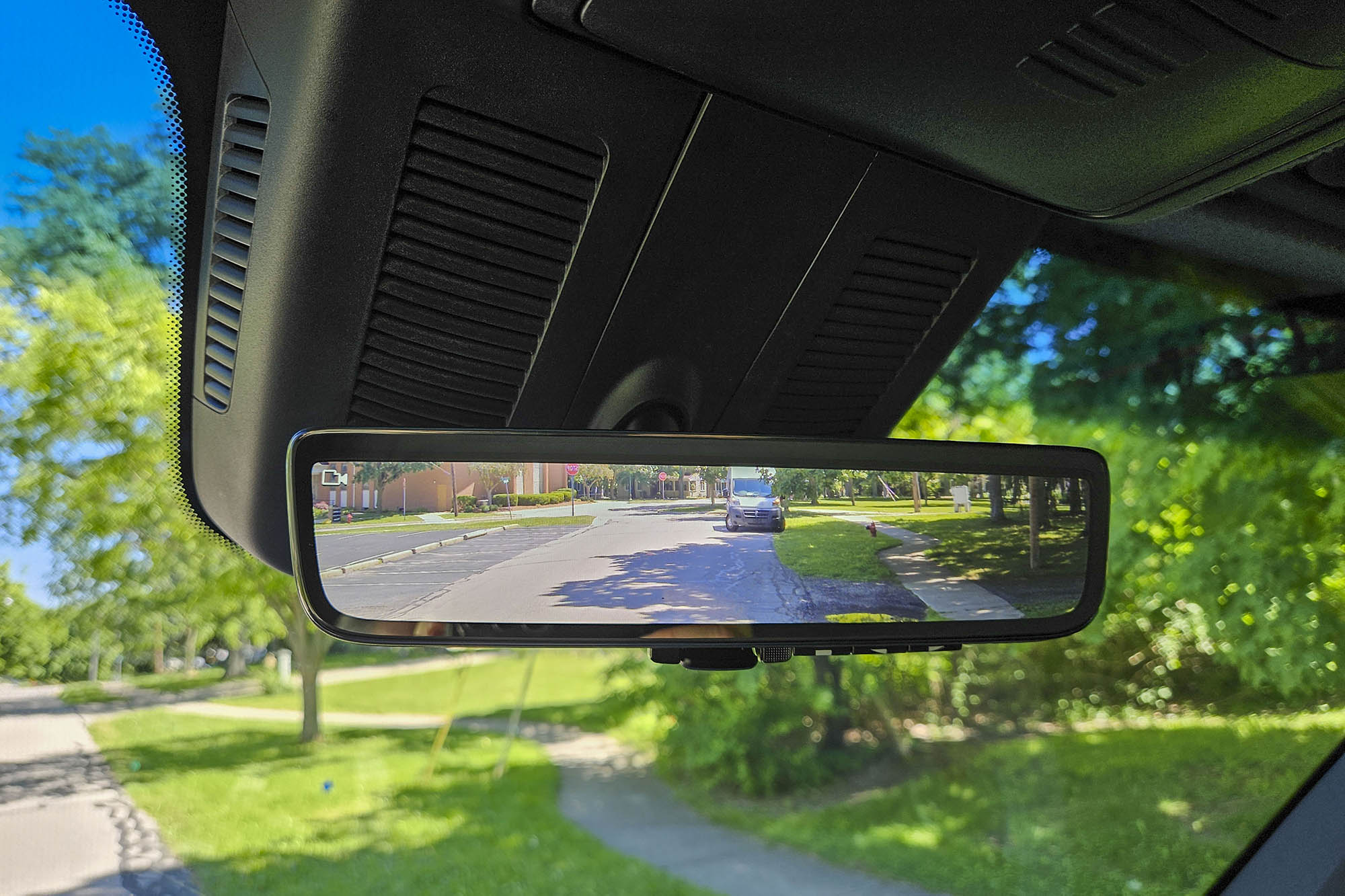 Perry Stern
Perry Stern
The Rearview Camera Mirror Is a Necessary Upgrade
A camera-based digital rearview mirror is a cool but unnecessary feature for many vehicles. That's not the case with the Mercedes-Benz eSprinter, where you might decide it is a necessity.
My test vehicle had a solid partition behind the front seats, separating the passenger cabin from the cargo area and making it impossible to see out of the van's rear windows. The optional digital rearview mirror solved that problem by projecting a live video feed from a rear-facing camera mounted at the top of the van onto the rearview mirror.
Separately, the eSprinter has a typical standard reversing camera. Together with the optional digital rearview mirror, these cameras provide an unobstructed view for safely reversing this 22.8-foot van.
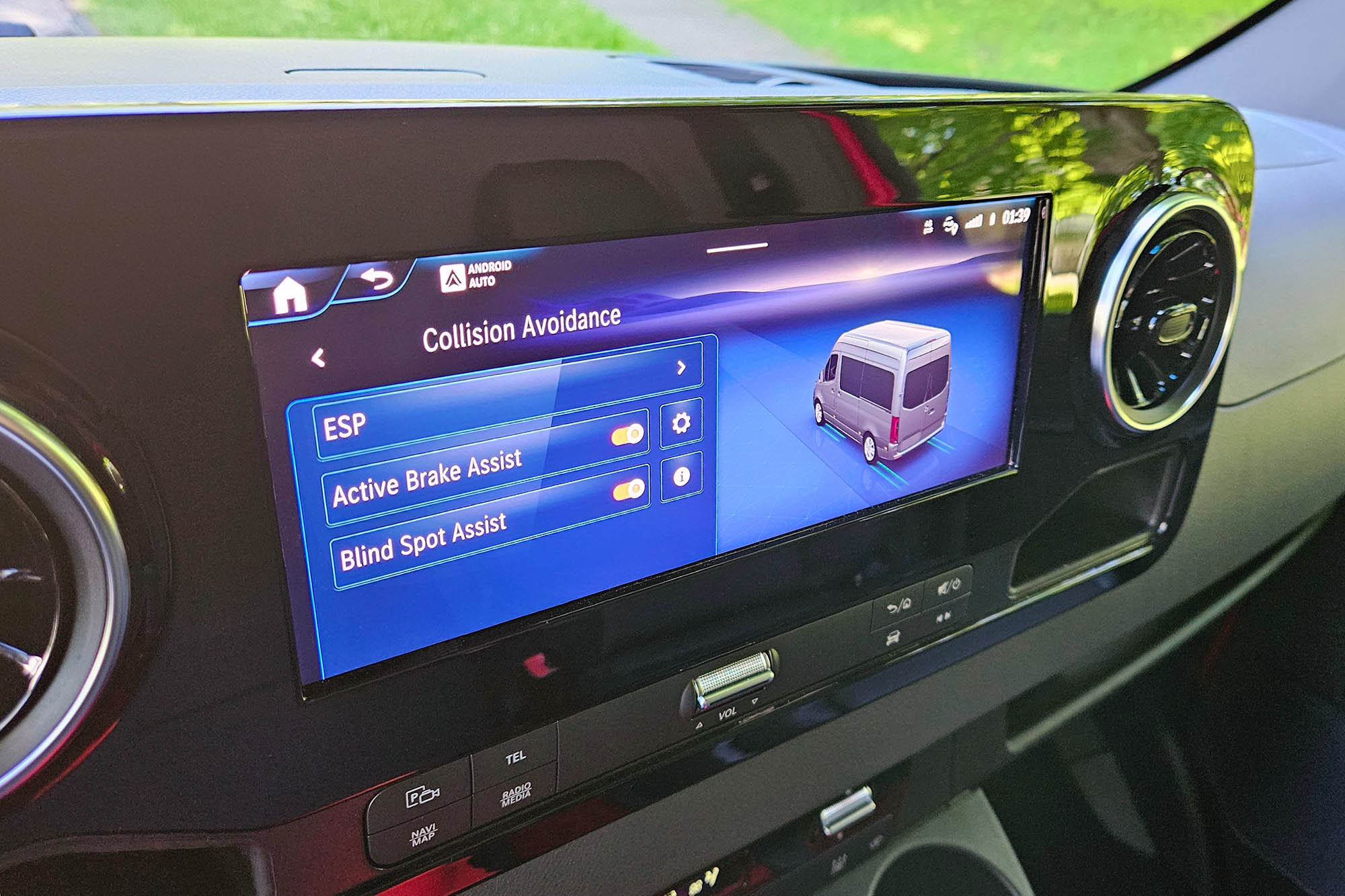 Perry Stern
Perry Stern
Few Safety Features Are Standard on the eSprinter
While the eSprinter has many features similar to those found in Mercedes-Benz passenger vehicles, the cargo van doesn't have the same number of safety systems.
For example, the only standard advanced driver-assistance systems are automated emergency braking and a Crosswind Assist stability system. Options include blind-spot monitoring, an Attention Assist driver monitoring system, and automatic high-beam headlights. Cruise control is also available, but it is not adaptive.
As with the backup camera and digital rearview mirror, I found the optional blind-spot monitoring system is critical to safely driving the eSprinter.
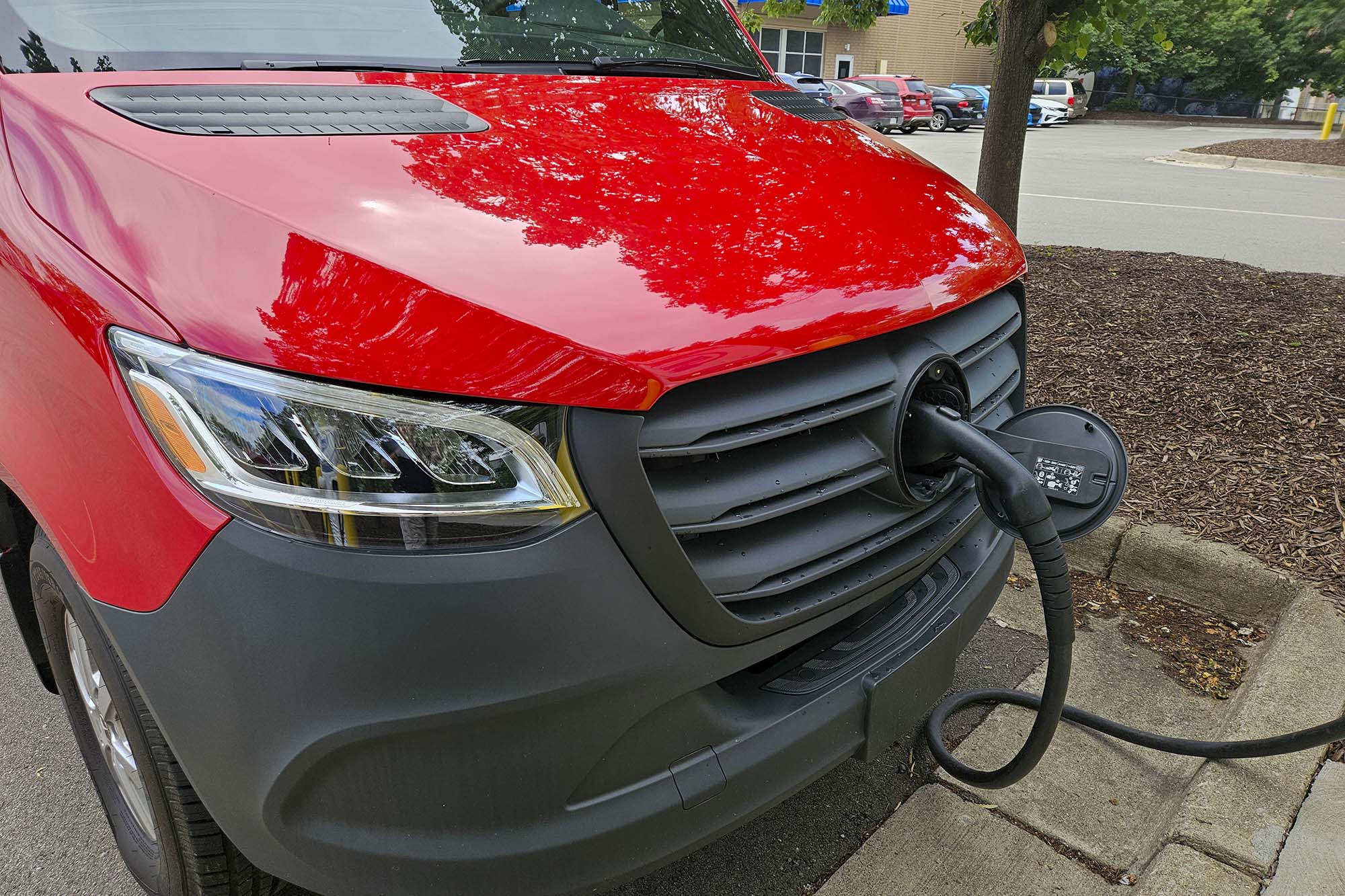 Perry Stern
Perry Stern
The eSprinter Is All-Electric
A permanent magnet synchronous (PSM) electric motor powers the eSprinter's rear wheels, supplying 204 horsepower and 295 pound-feet of torque. Diesel Sprinter vans offer all-wheel drive, and I wouldn't be surprised to see a dual-motor all-wheel-drive version of the eSprinter sometime in the future.
The eSprinter's 113-kWh battery uses lithium iron phosphate in its construction, eliminating the need for rare materials such as cobalt and nickel. Mercedes says this chemical composition provides better durability for commercial use, and the company provides an eight-year, 100,000-mile warranty on the battery.
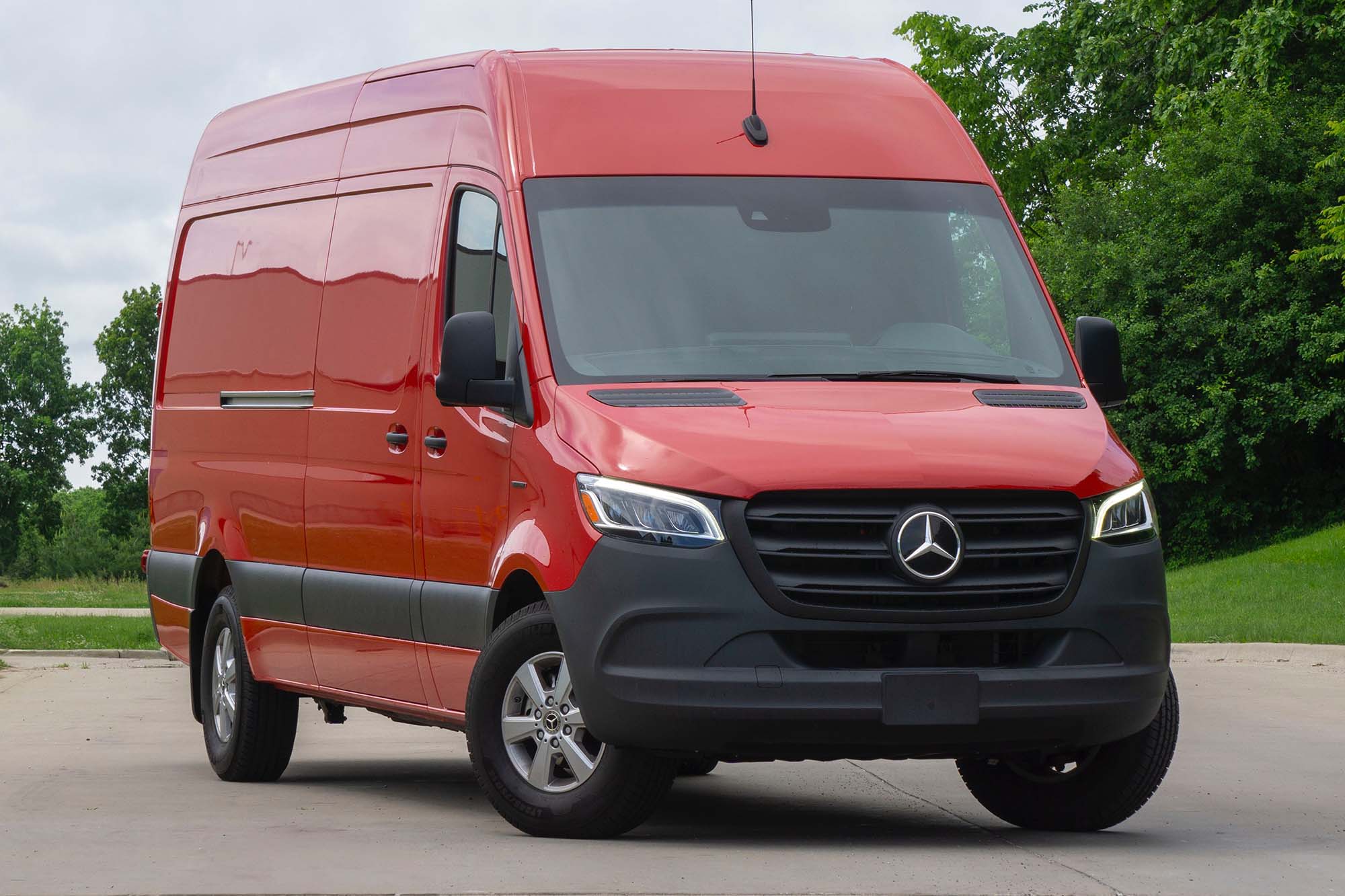 Perry Stern
Perry Stern
The eSprinter Is Surprisingly Smooth and Easy to Drive
Several large electric vehicles, such as the Ford F-150 Lightning and Hummer EV pickup trucks, boast impressive acceleration. The eSprinter is not like those vehicles. However, while the eSprinter won't accelerate like a rocket, it doesn't feel slow, and the electric motor delivers the smooth, uniform power expected of an EV.
Mercedes says the top speed of the eSprinter is 75 mph, which seems more than fast enough.
With its high seating position and large windshield, I found the eSprinter quite enjoyable to drive. It has adequate power for cruising around town and does so quietly. The battery pack's position below the cargo floor lowers the center of gravity so that the big van handles surprisingly well. I expected the eSprinter to feel ungainly and lean over when going around a corner. Instead, it felt pretty stable when turning.
At highway speeds, it does move around in its lane, and I experienced considerable buffeting at 70 mph. While the wind didn't get too bad during my time in the eSprinter, the van does have standard Crosswind Assist, which can apply braking to keep the eSprinter stable in high winds.
The eSprinter also features five levels of regenerative braking, which are adjustable via paddles on the steering column. The maximum setting applies the brakes when you lift your foot off the accelerator pedal, but there isn't enough stopping power for one-pedal driving.
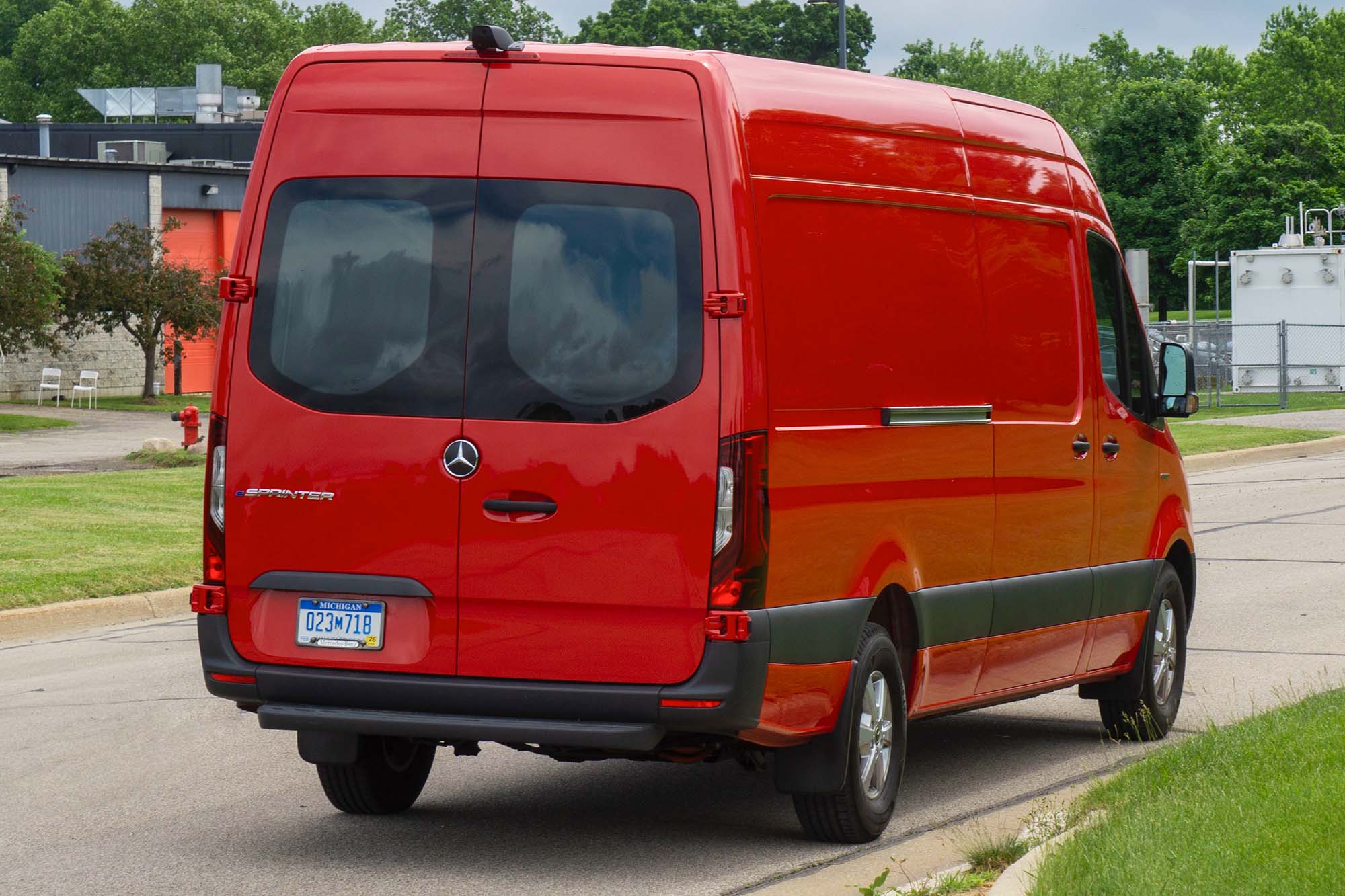 Perry Stern
Perry Stern
The EPA does not provide efficiency estimates for the Sprinter van (diesel or electric). During my testing, the eSprinter's trip computer showed an electricity consumption rate of 2.2 miles per kilowatt-hour (kWh), which equates to about 45 kWh per 100 miles or 74 MPGe.
Mercedes-Benz estimates a range of 273 miles on a full charge, but the company bases that figure on European testing methods, which are typically more optimistic than U.S. EPA data. I didn't have the opportunity to charge the eSprinter to 100%t, but with 185 miles of range at 82%, that extrapolates to an estimated 225 miles, which is better than what Ford and Rivian offer.
Speaking of charging, Mercedes says an eSprinter equipped with the optional 115-kW DC fast-charging capability can recharge from 10% to 80% in about 40 minutes. On a 9.6-kW Level 2 charger, it takes more than 12 hours to fully recharge the battery.
 Perry Stern
Perry Stern
The eSprinter Makes a Great Case for an Electric Cargo Van
There aren't many vehicles on the road that can boast the versatility and flexibility of a Mercedes-Benz Sprinter, and I think making it electric is a brilliant move. It offers numerous use cases and an efficient, low-maintenance powertrain, making it a compelling choice for a small business or as part of a fleet of delivery vehicles.
While the Ford eTransit and Rivian Commercial Van beat the Mercedes eSprinter to market, the 2024 Mercedes-Benz eSprinter's longer range, excellent driving characteristics, and quality cabin make it a strong contender in what is becoming a competitive segment.
Written by humans.
Edited by humans.
 Perry Stern
Perry SternAs a small child, Perry was constantly playing with toy cars and trucks, and that enthusiasm for anything motorized with wheels never faded. After college, he moved to Seattle and began his long automotive career working in an automotive consulting firm, helping customers choose the right vehicle for their needs. In the late 1990s, Perry joined Microsoft to work on CarPoint, part of the new Microsoft Network (MSN). He went on to become editor of the site, remaining on staff for 20 years before venturing out on his own. Today, in addition to his work on Capital One Auto Navigator, he still contributes to MSN, as well as J.D. Power, TrueCar.com, and U.S. News & World Report. Perry lives in the small town of Dexter, Michigan, with his wife and dog, and he still smiles when he sees his 2006 Mazda Miata in the garage.
Related articles
View more related articles